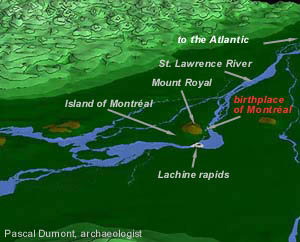|
|
|
Imagine, if you will, thousands of years ago, a wooded island rich with game, located at the junction of the St. Lawrence River and the Outaouais River... Amerindians regularly stopped here, and then returned their canoes to the water to continue eastward to the Atlantic Ocean, or portaged if they were continuing westward, to avoid the rapids blocking the route to the Great Lakes. |
Before
the Founding |
|
Back in those times, Old Montréal was an elongated ridge formed of several shelves running parallel to the St. Lawrence. The ridge, topped by a small hill (now disappeared), was separated from the rest of the island by a creek running along a marshy bed, which joined other streams to form a little river.
That little river, as it drained into the St. Lawrence, left a low-lying point of land at its mouth. It was on that point that the French settlers would one day found Montréal. |
|||
|
Amerindian camps Very early on, Amerindians set up camps on either side of the little river, a perfect natural harbour. Twentieth-century archaeologists would later find stone tools that could be some 4,000 years old. The Amerindian presence is known to date back at least 2,500 to 3,000 years.
|
||||
|
The First Europeans Arrive One day in the year 1535, Iroquois from the village of Hochelaga, on the island, watched as a group of French explorers led by Jacques Cartier came ashore. The adventurers were given a warm welcome. In 1603, Samuel de Champlain visited the island in turn, and found no village. When he returned in 1611, he installed his crew on the point, next to the mouth of the "little river." But the real founders of Montréal had yet to arrive...
|
||||
| Some key events | |
|
Early Woodland culture |
Nomadic populations visited the site of Old Montréal, leaving traces discovered by archaeologists. |
|
1535 |
Jacques Cartier visited the island and named the mountain Mont Royal — the likely origin of the name Montréal. |
|
1611 |
Explorer Samuel de Champlain also stopped here for a time, baptizing the site of his camp Place Royale, later renamed Pointe à Callière. |
|
| Home | Index | Contact us |
All
rights reserved, 1998.
Last updated: April 2000
|